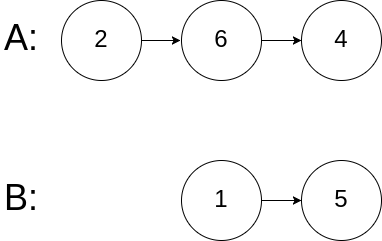Come from : [https://leetcode-cn.com/problems/intersection-of-two-linked-lists/]
160. Intersection of Two Linked Lists
1.Question
Write a program to find the node at which the intersection of two singly linked lists begins.
For example, the following two linked lists:

begin to intersect at node c1.
Example 1 :

Input: intersectVal = 8, listA = [4,1,8,4,5], listB = [5,0,1,8,4,5], skipA = 2, skipB = 3
Output: Reference of the node with value = 8
Input Explanation: The intersected node's value is 8 (note that this must not be 0 if the two lists intersect). From the head of A, it reads as [4,1,8,4,5]. From the head of B, it reads as [5,0,1,8,4,5]. There are 2 nodes before the intersected node in A; There are 3 nodes before the intersected node in B.
Example 2 :

Input: intersectVal = 2, listA = [0,9,1,2,4], listB = [3,2,4], skipA = 3, skipB = 1
Output: Reference of the node with value = 2
Input Explanation: The intersected node's value is 2 (note that this must not be 0 if the two lists intersect). From the head of A, it reads as [0,9,1,2,4]. From the head of B, it reads as [3,2,4]. There are 3 nodes before the intersected node in A; There are 1 node before the intersected node in B.
Example 3:

Input: intersectVal = 0, listA = [2,6,4], listB = [1,5], skipA = 3, skipB = 2
Output: null
Input Explanation: From the head of A, it reads as [2,6,4]. From the head of B, it reads as [1,5]. Since the two lists do not intersect, intersectVal must be 0, while skipA and skipB can be arbitrary values.
Explanation: The two lists do not intersect, so return null.
NOTE:
1. If the two linked lists have no intersection at all, return null.
2. The linked lists must retain their original structure after the function returns.
3. You may assume there are no cycles anywhere in the entire linked structure.
4. Your code should preferably run in O(n) time and use only O(1) memory.
2.Answer
easy 类型题目。。
我的方法1:(set集合方法–速度较慢)
AC代码如下:
/**
* Definition for singly-linked list.
* struct ListNode {
* int val;
* ListNode *next;
* ListNode(int x) : val(x), next(NULL) {}
* };
*/
class Solution {
public:
ListNode *getIntersectionNode(ListNode *headA, ListNode *headB) {
set<ListNode *> node_set;
while(headA)
{
node_set.insert(headA);
headA = headA->next;
}
while(headB)
{
if(node_set.find(headB) != node_set.end() )
{
return headB;
}
headB = headB->next;
}
return NULL;
}
};
我的方法2:(明天补充)
AC代码如下:
3.大神解答
速度排名第一。
/**
* Definition for singly-linked list.
* struct ListNode
* {
* int val;
* ListNode *next;
* ListNode(int x) : val(x), next(NULL) {}
* };
*/
class Solution
{
public:
ListNode *getIntersectionNode(ListNode *headA, ListNode *headB)
{
ListNode *a = headA, *b = headB;
while (a != b)
{
a = (a == nullptr ? headB : a->next);
b = (b == nullptr ? headA : b->next);
}
return a;
}
};
4.我的收获
链表。
fighting。。。
2019/6/26 胡云层 于南京 108